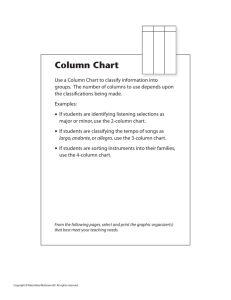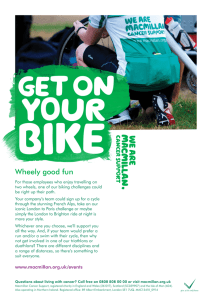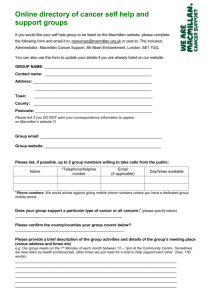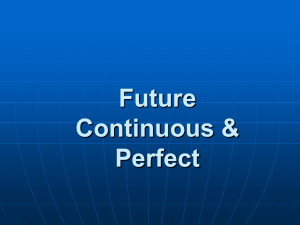Grade 4 Answer Key - Treasures - Macmillan/McGraw-Hill
advertisement
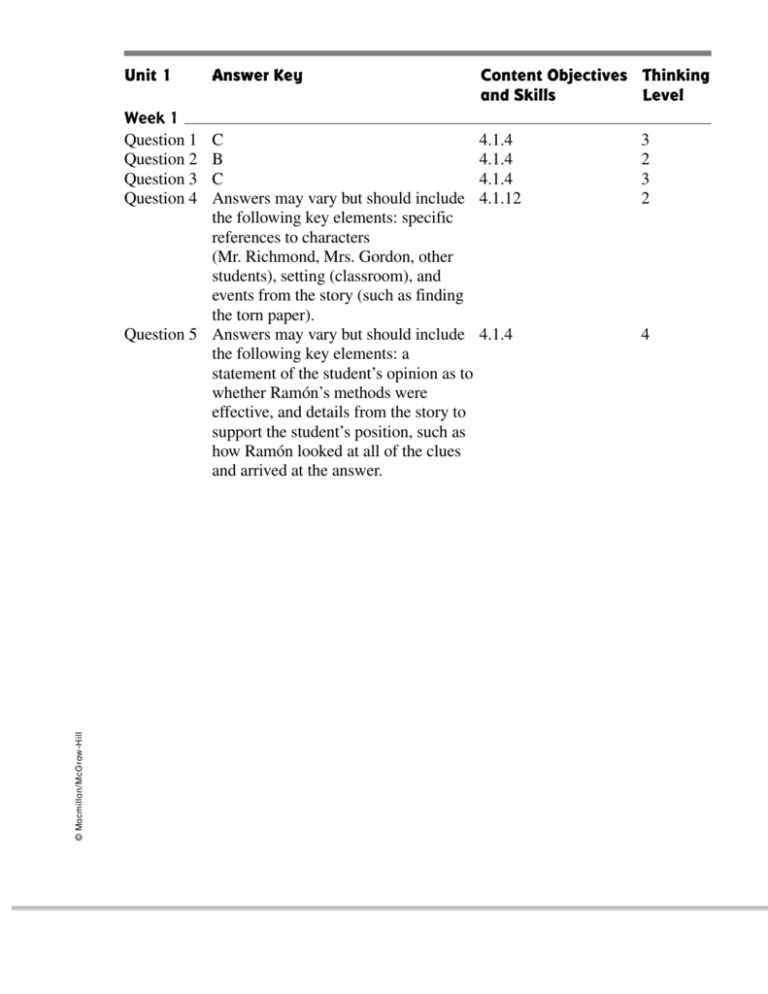
Unit 1 Week 1 Question 1 Question 2 Question 3 Question 4 Answer Key © Macmillan/McGraw-Hill C B C Answers may vary but should include the following key elements: specific references to characters (Mr. Richmond, Mrs. Gordon, other students), setting (classroom), and events from the story (such as finding the torn paper). Question 5 Answers may vary but should include the following key elements: a statement of the student’s opinion as to whether Ramón’s methods were effective, and details from the story to support the student’s position, such as how Ramón looked at all of the clues and arrived at the answer. Content Objectives Thinking and Skills Level 4.1.4 4.1.4 4.1.4 4.1.12 3 2 3 2 4.1.4 4 B D D Answers may vary but should include the following key elements: names of plants and animals mentioned in the selection and reasons why the student would like to see those plants and animals. For example, students may say they would like to see big saguaro cactus because they would like to see a plant that is very old. Question 5 Answers may vary but should include the following key elements: logical predictions about how people might adapt to the desert climate and details from the selection to support these predictions. For example, students might suggest building homes that are partly underground, like animal burrows, because they earth will help keep the inside cool during the day and warm at night. Week 3 Question 1 A Question 2 C Question 3 C Question 4 Answers may vary, but should include the following key elements: the name of the park that the student would like to visit and details from the story explaining why the student would like to visit that park. Question 5 Answers may vary but should include the following key elements: the government brought wolves back to the park; this put balance back into the park and allowed the animals to live as nature intended. 4.1.7 4.1.7 4.1.7 4.1.12 2 3 3 2 4.1.7 4 4.1.7 4.1.7 4.1.7 4.1.12 1 3 2 2 4.1.7 2 © Macmillan/McGraw-Hill Week 2 Question 1 Question 2 Question 3 Question 4 © Macmillan/McGraw-Hill Week 4 Question 1 Question 2 Question 3 Question 4 A 4.1.4 C 4.1.4 B 4.1.4 Answers may vary but should include 4.1.12 the following key elements: Would I be able to get a job like that? Is it difficult? Is it dangerous? What skills or education do I need to be good at this job? Do you enjoy your work? Question 5 Answers may vary but should include 4.1.4 the following key elements: a completed web with four of Gloria’s character traits, such as smart, curious about space, daring, energetic; an explanation of how these character traits might help her become an astronaut; and details from the story that support the student’s position. Week 5 Question 1 C 4.1.4 Question 2 B 4.1.4 Question 3 C 4.1.4 Question 4 Answers may vary but should include 4.1.12 the following key elements: a description of activities the student would have done with the raft and details from the story to support the student’s ideas. For example, students might say they would fish and swim in the river, and see new animals. Maybe some would sketch. Question 5 Answers may vary but should include 4.1.7 the following key elements: both characters thought they would not like the place they were going; after they were on the river though, they discovered they liked rafting, being outdoors, and watching animals. 3 2 3 4 2 3 3 3 2 3 Unit 2 Week 1 Question 1 Question 2 Question 3 Question 4 Answer Key © Macmillan/McGraw-Hill A D B Answers may vary but should include the following key elements: a description of a time when the student reached a goal he or she had thought was impossible to achieve, and details from the story to support the student’s position. For example: students may say they received a good grade in a subject that was very difficult for them. Question 5 Answers may vary, but should include the following key elements: a description of how women’s role in baseball changed from the 1930s to the 1940s, an explanation of what caused that change and details from the story to support the student’s position. For example: In the 1930s, people felt that baseball was a man’s game and woman shouldn’t be allowed to play. But in the 1940s, during World War II, to keep the baseball parks open, women were asked to play and they had their own league. Content Objectives Thinking and Skills Level 4.1.11 4.1.4 4.1.4 4.1.7 3 2 3 2 4.1.7 3 C A A Answers may vary but should include the following key elements: a clear statement describing what the student would like Amada to write about, and details from the story to support the student’s position. For example, students may say that they would like Amanda to write about her new friends in Los Angeles. Question 5 Answers may vary but should include the following key elements: a statement describing how Amada’s feelings compare with those of her brothers, a description of the feelings they share, and details from the story to support the student’s position. For example, at first Amada was worried about moving and her brothers were excited; when they finally crossed the border they seemed a little sad; but they are all excited to see Papá. 4.1.7 4.1.7 4.1.7 4.1.12 2 2 3 3 4.1.4 3 © Macmillan/McGraw-Hill Week 2 Question 1 Question 2 Question 3 Question 4 Week 3 Question 1 Question 2 Question 3 Question 4 © Macmillan/McGraw-Hill C C B Answers may vary but should include the following key elements: a clear statement of a theme the two stories have in common, and details from the article to support the student’s position. For example, both articles are about the importance of preserving and keeping safe ancient art; people are working to preserve and protect ancient treasures in both stories. Question 5 Answers may vary but should include the following key elements: stealing ancient treasures has become a major problem; people believe that stealing artwork is like stealing a country’s culture; most theft of ancient art is not reported. 4.1.7 4.1.7 4.1.4 4.1.7 1 3 2 3 4.1.7 2 C C D Answers may vary but should include the following key elements: a clear statement of how the student would improve an invention in the story and what invention the student would create, and details from the story and the student’s own life to support the student’s position. For example, students might say that they would try to find a way to use the electricity when lightning hits the rod. Question 5 Answers may vary but should include the following key elements: a clear statement of whether the student thinks that Ben Franklin was ever bored, and details from the story to support the student’s position. For example: Ben Franklin kept himself so busy with inventing new things or thinking of new ideas that he probably never had time to be bored. 4.1.7 4.1.7 4.1.7 4.1.12 1 2 3 3 4.1.7 3 © Macmillan/McGraw-Hill Week 4 Question 1 Question 2 Question 3 Question 4 Week 5 Question 1 Question 2 Question 3 Question 4 © Macmillan/McGraw-Hill A D C Answers may vary but should include the following key elements: a clear statement of whether the student feels Cara’s apology was genuine and details from the story to support the student’s position. For example, Cara may be truly sorry that Mr. Winston was scared by the snake, but she admits that she’s writing because her parents told her to apologize, so it doesn’t seem very genuine; she is even angry at having to write the letter. Question 5 Answers may vary but should include the following key elements: a clear statement explaining how the student could have avoided Cara’s mistake and details from the story and the student’s own life to support his or her position. For example, the students may say they would have taken a photo of the snake with them to the library instead of the actual snake. 4.1.4 4.1.4 4.1.4 4.1.4 2 3 3 3 4.1.12 3 Unit 3 Week 1 Question 1 Question 2 Question 3 Question 4 Answer Key © Macmillan/McGraw-Hill A D C Answers may vary but should include the following key elements: a description of how the student would have dealt with a bully like Snake, and details from the story and the student’s own life to support his or her position. For example, students may say that they would get everyone together and invite the bully to discuss a solution. They might tell the bully that no one could scare them or tell them what to do. Question 5 Answers may vary but should include the following key elements: a clear statement of what the student learned from the story that he or she did not learn from “Roadrunner’s Dance,” and details from the story to support the student’s position. For example, the reader learns that roadrunners can run up to 15 mph and fly for a few seconds to guard young from enemies. Content Objectives Thinking and Skills Level 4.1.4 4.1.4 4.1.4 4.1.12 3 3 3 3 4.1.7 3 D B D Answers may vary but should include the following key elements: a clear statement of why the student thinks the author wrote about her brother’s childhood experiences and details from the story to support the student’s position. For example, it was during her brother’s childhood that he first experienced prejudice and decided to take action; he held on to his goals to change the world for many years before he finally followed through with it. Question 5 Answers may vary but should include the following key elements: a clear statement explaining why the student feels it is important to correct injustice, and details from the story and the student’s life to support his or her position. For example, all people are equal and should be treated equally; they feel hurt when they have been rejected because of their race, gender, or class. Week 3 Question 1 C Question 2 B Question 3 B Question 4 Answers may vary but should include the following key elements: a clear description of the topic the student would like to investigate and an explanation of why that topic is interesting to the student. 4.1.5 4.1.4 4.1.4 4.1.11 2 2 3 3 4.1.12 4 4.1.7 4.1.7 4.1.7 4.1.12 3 2 3 4 © Macmillan/McGraw-Hill Week 2 Question 1 Question 2 Question 3 Question 4 Week 4 Question 1 Question 2 Question 3 Question 4 © Macmillan/McGraw-Hill C A C Answers may vary but should include the following key elements: a clear statement of how the student would correct the mistake and repair the friendship, and details from the story and the student’s own life to support his or her position. For example, students may say they would apologize and promise never to make the mistake again; they might do nice things for the friend to show that they really care. Question 5 Answers may vary but should include the following key elements: a clear description of what the student learned about Pawnee life from both selections, and details from the stories to support the student’s ideas. For example, the Pawnee were traveling people who hunted, farmed, and used their resources wisely. 4.1.7 4.1.7 4.1.7 4.1.12 1 3 3 4 4.1.7 3 D C C Answers may vary but should include the following key elements: a clear statement of what the student would study, an explanation of why the student chose that subject, and details from the story to support the student’s position. Question 5 Answers may vary but should include the following key elements: a clear statement of why it is important to study even microscopic things in the world, and details from the story to support the student’s position. For example, studying the world around you might help you discover something new like Snowflake Bentley’s snowflakes; it may also help you to appreciate the world in which you live. 4.1.4 4.1.4 4.1.7 4.1.12 2 2 3 4 4.1.12 4 © Macmillan/McGraw-Hill Week 5 Question 1 Question 2 Question 3 Question 4 Unit 4 Week 1 Question 1 Question 2 Question 3 Question 4 Answer Key © Macmillan/McGraw-Hill C D C Answers may vary but should include the following key elements: a clear statement of whether the student would believe Ike’s letters and details from the story to support the student’s position. For example, the drawings show that most of what Ike says about obedience school and about the cats is not really true; students will probably conclude that Ike is not very truthful. Instead he is painting a melodramatic picture of how he is suffering. Question 5 Answers may vary but should include the following key elements: a clear statement of why the student thinks some people exaggerate and details from the story to and the student’s own life to support the student’s position. For example: People may exaggerate because they don’t want to get into trouble, or because they want someone to feel sorry for them. Content Objectives Thinking and Skills Levels 4.1.4 4.1.4 4.1.3 4.1.12 3 2 1 3 4.1.12 4 B B D Answers may vary but should include the following key elements: a description of what would happen if more people solved their problems with wisdom the way Chirobo does and details from the story to support the student’s position. For example, students might say if people solved their problems with wisdom, perhaps there would be less fighting in the world. Question 5 Answers may vary but should include the following key elements: a question that the student would ask Chirobo and details from the story and the student’s own life to support the student’s position. For example, students may say that they would ask Chirobo how he became so wise or how he learned to be so patient. 4.1.4 4.1.4 4.1.12 4.1.12 2 3 3 4 4.1.12 4 © Macmillan/McGraw-Hill Week 2 Question 1 Question 2 Question 3 Question 4 Week 3 Question 1 Question 2 Question 3 Question 4 © Macmillan/McGraw-Hill C C C Answers may vary but should include the following key elements: a description of the argument the student would make, the persuasive techniques the student would use, and details from the article to support the student’s position. For example, students may say they would use the argument that hybrids use less gas, thus saving money, and that hybrids are better for the environment. Question 5 Answers may vary but should include the following key elements: a brief summary of the main points covered in “The Power of Oil.” For example: Oil is a messy fossil fuel that is used that powers millions of vehicles and factories. When oil burns, it releases a great deal of pollution into the air, which harms our environment and causes global warming. In addition, oil spills are polluting our oceans and killing sea life. Because of this, we must start finding ways to use oil in a more efficient way, such as by driving hybrid cars. 4.1.7 4.1.7 4.1.7 4.1.12 1 2 2 3 4.1.7 2 B C B Answers may vary but should include the following key elements: a description of the steps the student would take to organize the club to study the whales and details from the story and the student’s own life to support the student’s position. For example, students might say they would get permission from their school to start a club. They might put up posters to try to persuade other students to join and then do research to learn more about whales. Question 5 Answers may vary but should include the following key elements: a statement outlining what the student learned about whales from the article that was not in the story and details from the stories to support the student’s position. For example: In “A Whale of a Trip!” we learn about baleen whales, how they eat, and how they need to be protected from tuna fishing nets. The story of “Adelina’s Whales” not only talks about whales, but it also tells us about Adelina’s community. 4.1.7 4.1.7 4.1.12 4.1.12 1 3 2 4 4.1.12 3 © Macmillan/McGraw-Hill Week 4 Question 1 Question 2 Question 3 Question 4 Week 5 Question 1 Question 2 Question 3 Question 4 © Macmillan/McGraw-Hill D A B Answers may vary but should include the following key elements: a completed Venn Diagram, a description of how the sandy beach and the coral reef are alike and how they are different, and details from the story to support the student’s position. For example: The sandy beach is made up of the skeletons of reef animals and plants that were pounded into bits by the waves. The water by the beach is shallower than that by the reef. The weather is hotter. The reef is sunny, not too hot, and alive with colorful animals and plants. The beach has only sand. Question 5 Answers may vary but should include the following key elements: a description of changes the student would make to avoid adding pollution to the ocean, an explanation of how those changes would be good for the ocean, and details from the story and the student’s own life to support the student’s position. For example, students may say they could use shampoos and detergents that do not pollute water. They might also say that if they visited a coral reef, they would be careful not to leave trash in the water or touch the reef. 4.1.7 4.1.7 4.1.7 4.1.7 2 3 3 3 4.1.12 4 Unit 5 Week 1 Question 1 Question 2 Question 3 Question 4 Answer Key © Macmillan/McGraw-Hill C A D Answers may vary but should include the following key elements: a summary of Miss Franny Block’s story. For example: Miss Franny’s father built her a library in Florida when she was a young girl. One day she was in the library when a bear walked in. She was afraid the bear would eat her so she threw a book at him. She scared him off, but he took the book away with him. Question 5 Answers may vary but should include the following key elements: a description of a funny story that the student would share with a new friend and details from the story and the student’s own life to support the student’s position. For example, students might tell about their first day of school or an unusual event. Content Objectives Thinking and Skills Levels 4.1.4 4.1.5 4.1.7 4.1.4 3 2 3 1 4.1.12 2 A C C Answers may vary but should include the following key elements: a description of how the student would respond to the deal that Ranita offered Felipe and details from the story and the student’s own life to support the student’s position. For example, students may say that they would follow through on their promises to Ranita because they feel sorry for her and want to help. Question 5 Answers may vary but should include the following key elements: a clear statement explaining whether the student feels Felipe deserved the punishment he received for being selfish and details from the story to support the student’s position. For example, students may say that Felipe deserved his punishment because he acted selfishly, treated Pepe and Ranita badly, and broke his promise. 4.1.4 4.1.4 4.1.4 4.1.12 2 2 3 4 4.1.12 4 © Macmillan/McGraw-Hill Week 2 Question 1 Question 2 Question 3 Question 4 Week 3 Question 1 Question 2 Question 3 Question 4 © Macmillan/McGraw-Hill B C C Answers may vary but should include the following key elements: explanation of how past and present explorers are alike and details from the stories to support the student’s position. For example, students might say that explorers take risks in order to prove how valuable exploration is to discovering the past and improving the future. Question 5 Answers may vary but should include the following key elements: a brief summary of the main points covered in “Exploring the Undersea Territory.” For example: The ocean is very important because it supplies the world with most of its oxygen, and it even shapes climate and the weather. Until recently, it was very hard to explore the ocean, which is why much of it is unexplored. But new technology is allowing people like Sylvia Earle and Robert Ballard to explore things like ocean life and ancient shipwrecks. Both explorers hope to learn more about the world’s past and present by exploring the ocean’s depths. 4.1.7 4.1.7 4.1.7 4.1.12 2 3 3 4 4.1.7 2 B A C Answers may vary but should include the following key elements: a description of a time when the student was mistaken about someone’s character based on the person’s appearance and details from the student’s own life to support the student’s position. For example, students may give examples of family members or friends whom they didn’t like at first based on looks, but then discovered were good people. Question 5 Answers may vary but should include the following key elements: an explanation of why the student thinks art is a good way to express feelings and ideas and details from the story and the student’s own life to support the student’s position. For example: Art can tell a story about who you are or what you are thinking. It can also remind you about something from the past. 4.1.4 4.1.4 4.1.4 4.1.12 2 2 3 2 4.1.12 4 © Macmillan/McGraw-Hill Week 4 Question 1 Question 2 Question 3 Question 4 Week 5 Question 1 Question 2 Question 3 Question 4 © Macmillan/McGraw-Hill D C B Answers may vary but should include the following key elements: a description of what the student would do if he or she found a horse drinking soapy dishwater and details from the story and the student’s own life to support the student’s position. For example, students may say they would not let the horse keep drinking soapy water. They would bring clean water for the horse instead. Question 5 Answers may vary but should include the following key elements: an explanation of why it is important to care for and protect animals and details from the story and the student’s own life to support the student’s position. For example: Animals help keep the environment in balance. If the world loses an entire group of animals, it can cause problems in the environment. 4.1.7 4.1.7 4.1.7 4.1.12 2 2 3 2 4.1.12 4 Unit 6 Week 1 Question 1 Question 2 Question 3 Question 4 Answer Key © Macmillan/McGraw-Hill A D C Answers may vary but should include the following key elements: a clear description of how the student would change the plot to include one of Matt’s ancestors, a description of a character the student would invent to fit into the story, and details from the story to support the student’s position. For example, students might invent a young Irish character who was as strong and determined a pioneer as Eric’s great-great-great-grandfather. Question 5 Answers may vary but should include the following key elements: an explanation of why it is important for people to learn about their family’s history and details from the story and the student’s own life to support the student’s position. For example, students may say that finding out about their family’s history is important in order to discover who they really are and develop a deeper appreciation for family. Content Objectives Thinking and Skills Level 4.1.4 4.1.4 4.1.7 4.1.12 2 2 3 4 4.1.12 4 A B D Answers may vary but should include the following key elements: a clear statement of which character the student would choose to be and details from the story that explain the student’s position. For example, students may say that they would rather be Tucker because he is very energetic and outgoing. Some students might prefer to be Chester because he is quiet, and a talented musician. Question 5 Answers may vary but should include the following key elements: a description of how the student would decide if it is a good idea to stay in the city and details from the story to support the student’s position. For example, students may say that if they were Chester, they might feel better about staying in the city because of friends like Tucker and Harry. 4.1.4 4.1.4 4.1.7 4.1.12 2 2 3 4 4.1.12 4 © Macmillan/McGraw-Hill Week 2 Question 1 Question 2 Question 3 Question 4 Week 3 Question 1 Question 2 Question 3 Question 4 © Macmillan/McGraw-Hill C A A Answers may vary but should include the following key elements: a clear statement of whether the student would like traveling as much as Sue Hendrickson does and details from the selection and the student’s own life to support the student’s position. For example, students might say they would like to travel because they enjoy adventure. Question 5 Answers may vary but should include the following key elements: clear evidence that the student has grasped the main focus of the selection and a brief summary of the main points the author mentions. For example: Sue Hendrickson had always been curious about the world around her, and this led her to become a paleontologist. Hendrickson spends much of her time exploring and digging up artifacts in countries all over the world. She considers her biggest discovery to be a T. Rex skeleton that she found by accident in South Dakota. Hendrickson has also done some exploration work underwater, diving deep into waters off the coasts of Egypt, China, and Cuba to search for lost cities, shipwrecks, and buried treasures. 4.1.7 4.1.7 4.1.7 4.1.12 1 1 3 4 4.1.4 2 B A D Answers may vary but should include the following key elements: a description of what the student’s headline and article would say and details from the story to support the student’s position. For example, a possible headline might be: “Wright Brothers Fly into History.” The article might read, “On December 17, in Kitty Hawk, the Wright brothers’ aircraft took off into the air like a bird.” Question 5 Answers may vary but should include the following key elements: a clear statement of whether the student feels that the Wright brothers would have succeeded without the support of their sister, an explanation as to why or why not, and details from the story to support the student’s position. For example, students may say that the Wright brothers would have had a harder time being successful without Katherine Wright. 4.1.4 4.1.4 4.1.7 4.1.12 2 3 3 4 4.1.7 4 © Macmillan/McGraw-Hill Week 4 Question 1 Question 2 Question 3 Question 4 Week 5 Question 1 Question 2 Question 3 Question 4 © Macmillan/McGraw-Hill D B D Answers may vary but should include the following key elements: a description of the inside of an anthill and details from the selection to support the student’s position. For example: An anthill is made out of little bricks packed together to form underground tunnels and chambers. It absorbs heat from the sun, so it can be warmer than the area around it. Question 5 Answers may vary but should include the following key elements: a description of how the student could use the information about ants to overcome a problem and details from the selection and the student’s own life to support the student’s position. For example, students may say that if they had a problem they would try to work with others like ants do. They might also say they would give each person a job to do, so that everyone would take part in helping to solve a problem. 4.1.7 4.1.7 4.1.7 4.1.7 3 3 3 2 4.1.12 4
